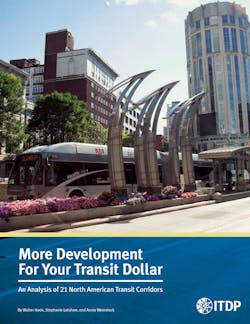More Development for Your Transit Dollar: An Analysis of 21 North American Transit Corridors
ITDP’s report, “More Development for Your Transit Dollar: An Analysis of 21 North American Transit Corridors,” evaluates 21 surface mass transit corridors in 13 cities across the United States and Canada. The corridors were all rated using The BRT Standard, which assesses how closely the systems conform to international ‘best practices,’ and can be used to evaluate light rail transit (LRT) as easily as it can BRT. The report then discusses how each system has served as a catalyst or anchor for urban development.
The findings of the report include:
- Government support is the best predicator of transit-oriented development, regardless of system type. Governments can invest in related infrastructure, change the zoning and other regulations, provide loans or tax abatements, and market the area to help support development. But if a government does nothing to support TOD along the transit corridor, there will be no impact.
- Bus rapid transit leverages more transit-oriented development per dollar spent on building transit than light rail transit or streetcars. Cleveland’s HealthLine BRT and Portland’s MAX Blue Line LRT leveraged the most overall TOD of the corridors studied — $5.8 billion and $6.5 billion, respectively. Yet, because the HealthLine cost significantly less to build than the Blue Line, Cleveland leveraged approximately 31 times more TOD per dollar spent on its HealthLine than Portland for its Blue Line.
- The strength of the land market around the transit corridor is the secondary indicator of success. Where governments provide moderate development support, the attractiveness of the land determines the level of TOD investment. Today, downtowns tend to begin as stronger land markets, so routing transit through a city’s downtown leads to better TOD impacts.
- A higher quality transit investment, as scored by The BRT Standard, helps leverage more development in emerging land markets.
